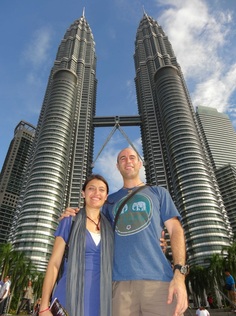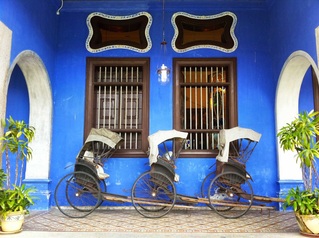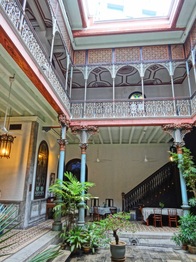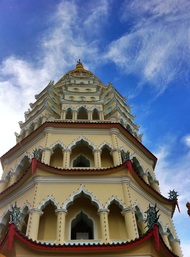



Dim Sum’s roots lay buried in Southern China where the ancient tradition of tea tasting was popular. As the silk road grew more crowded with travelers and people discovered that tea aided in digestion, it made sense to offer some snacks with the tea. Lucky for us, those snacks were so delicious and varied, that the tradition stuck and Dim Sum was born. Literally meaning, “touch the heart”, I think the Chinese may have had some inkling of how unhealthy these little delectable morsels were when they came up with the name – if you’re not moderate they literally will touch your heart! But as we flew into Kuala Lumpur and got our first experiences of the city, we realized that the idea of dim sum really epitomizes the cultural smorgasbord found in the country. In addition to the indigenous Malay population, India and China have both been actively trading with the strategically located peninsula since around the 2nd century AD. By the 11th century Islam had spread across the country via trade and in the 16th century the Dutch established a strong presence, followed finally by the British in the 18th century.  But the highlight of the city came in a pair. The Petronas Towers rise 1,500 meters in the air and seem almost like giant minarets visible from anywhere in the city. The towers are the home of the country’s national oil company, but also incorporate Islamic geometric principles as they rise in the shape of an eight-sided star. Under the towers sits an enormous mall while in their shadow is a large park with a wave pool - a playground for kids. All in all, it’s a wonderfully designed space, perhaps best appreciated from above. To do so, we headed to the nearby Trader’s Skybar, with views straight to the towers and attached park. As day turned to night, we watched the towers light up like shimmering crystals protesting the darkness. The sight of this architecture, turned into mesmerizing, incandescent sculpture as the night fell, was a true highlight. Add to that our first beer in 6 weeks (we didn’t drink while in India) and the night was complete!  Cheong Fatt Tze Mansion After Kuala Lumpur we headed to the Cameron Highlands for adventures with tea (see our post about that here), before heading to the island of Penang, in the northwestern part of the peninsula. Penang’s history started to get really interesting in 1786 when the Sultan of Kedah ceded Penang to the British East India Company in an attempt to gain protection against Siam (though it didn’t work). The British established Penang and other small territories along the coast of Malaysia (called the “Straits Settlements”) to use them as free trade ports. As such, an enormous mixture of people combined there, making a veritable dim sum cart of cultures. There were the indigenous Malays, the Chinese (who had come in droves when tin was discovered in Malaysia), the Klings (southern Indians), and of course the Europeans. In addition, a new culture known as Pernakan was created out of the marriages of Malays and Chinese.  traditional atrium The mixture finds its apex in the delightful city of Georgetown on Penang. Old Chinese shop houses sit across Anglican churches (and a British fort) while Little India booms out music and the local Malays worship at the white-washed mosques. We stayed in a Chinese heritage house, formerly a shop house and family home all in one. It had a beautiful atrium in the middle - a necessity in Chinese Feng Shui, which believes that rain water must be able to enter the home as it symbolizes the coming of wealth. From there, we explored the city and island and its many gustatory delights. Each morning would find us participating in the ritual of dim sum, where a pot of loose leaf Chinese tea was served as women would cart around trays with little dishes of goodies you could choose. Some of our favorites were the deep fried pork rolls, the Chinese white bun stuffed with chicken, egg, and mushroom, and the crab and sesame seed topped dumplings! When we were sated on meat, the city also had a variety of economical vegetarian buffets, where you could fill up your plate with healthy greens and delightful tofu dishes for just a few dollars.  Pagoda of 10k Buddhas After our big breakfasts, we would do some sightseeing before retreating back to our wonderful room for a respite from the smothering heat. The one day we rented a motorbike and braved the heat, however, we did manage to see many of the sites outside of Georgetown. This included Wat Chayamangkalaram, a massive Thai temple with a huge reclining Buddha inside, and Kek Lok Si Temple, the largest Buddhist temple in all of Malaysia. Kek Lok Si sports a massive statue of Kuan Yin (the bodhisattva of compassion) as well as the towering Pagoda of Ten Thousand Buddhas, which was designed in Chinese, Thai, and Burmese styles to represent the unity of the different types of Buddhism. Perhaps most unique however, was Ban Kah Lan, or the snake temple, where many years ago monks had allowed the local venomous Wagler’s pit vipers to live on the grounds rather than kill them. Over time, this developed as the temple’s primary attraction and a visit sees the vipers not only on branches curving next to the altar, but resting on branches all over the trees behind the temple. Be warned that it’s good to visit during the day when the vipers are sleeping – a trip at night may be your last! The Chinese architecture in Georgetown was impressive as well. The Cheong Fatt Tze Mansion showed the opulence enjoyed by one of China’s richest businessmen at the turn of the 20th century. Nearby, the Khoo Kongsi temple and other clan temples have intricate carvings and statues meant to honor the clans of the immigrants who had moved there. We also happened to be in Penang over the Christmas holiday and the friendliness of the locals was matched by the friendliness of the local Couchsurfing Community. Brian and Magda, a wonderful couple from Canada and Poland respectively, decided to host a Christmas Eve potluck for couchsurfers in the area. The evening was full of fun and conversation as we had travelers from Hungary, India, Romania, Spain, and locals all mixing to share food and experiences. The next day we all met up again for an Indian Christmas dinner and drinks. All in all, we loved our time in Malaysia as we got to choose all the goodies we wanted from our dim sum cart - good people, good food, and great cultural variety. Now we are in New Zealand, but on the way here we had an 11 hour layover on the Gold Coast of Australia. So why not hit the beach? We threw our bags in a locker, changed into our swimsuits and a 10 minute bus ride later we were having a great time riding the waves in the beautiful azure green water. Our updates for New Zealand will be sporadic at best as we cruise our Toyota Estima with a futon in the back around the two islands! We hope to wrap up the purchase of the van in a couple days and in the meantime had a great New Year's Eve out on a beach house of our friends Chris and Lauren, who we have re-united with for the next week or so! You might remember them from Cambodia and Vietnam!
1 Comment
Brett F.
1/15/2013 01:24:25 am
wow, wow, wow. i want to quit my job and come meet you!!!!!!!! Leave a Reply. |